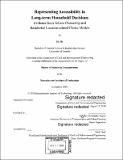Representing accessibility in long-term household decisions evidence from vehicle ownership and residential location-related choice models
Author(s)
He, He (Civil and environmental engineer) Massachusetts Institute of Technology
DownloadFull printable version (5.811Mb)
Other Contributors
Massachusetts Institute of Technology. Department of Civil and Environmental Engineering.
Advisor
Pericles Christopher Zegras.
Terms of use
Metadata
Show full item recordAbstract
This study examines variations in representing accessibility and how well these representations reflect people's preferences for accessibility as observed in their behaviour in long-term transportation and location-related decisions. Specifically, we estimate household vehicle ownership models and real estate market price models with different measures of accessibility. Better performing accessibility measures are better representations of accessibility - at least for the purposes of explaining the modelled behaviour. We compare gravity-based accessibility, an aggregate measure of potential; trip-based accessibility, a disaggregate measure of utility; and activity-based accessibility, a disaggregate measure of utility that also captures the effect of individuals' activity schedules. We find that (1) disaggregate accessibility perform better in explaining disaggregate (e.g. household-level) behaviour; (2) although measures of potential can be useful as performance indicators, people and market behaviour are better explained by measures of utility; and (3) the current formulation of the activity-based accessibility measure performs no better than the trip-based measure, likely due to imperfections in its operationalization in the relevant models, e.g., inadequate in its representation of activity schedule effects.. We then examine activity-based accessibility in more detail. In particular, we consider different interpretations by changing its benchmark, i.e. the hypothetical scenario relative to which benefits are measured. Furthermore, we examine the effects of measuring accessibility in units of time or money instead of utility. For benchmarks, we find that using a "no out-of-home activity participation"-scenario appears most appropriate. For rescaling, the most appropriate unit of measure depends on the explained behaviour. For example, for explaining the market price of real estate, which itself is measured in dollars, dollar-scaled accessibility performed best. The overall takeaway from these tests is that a single "best" measure of accessibility does not necessarily exist; different measures have their own advantages and limitations vis-à-vis theoretical appeal, data requirements, communicability, etc. What is imperative is that we understand what each measure actually captures and that this aligns with the purpose for which we use it. Finally, we examine the limitations of the estimation of the real estate willingness-to-pay function in SimMobility's bidding model, and propose an alternative estimation method.
Description
Thesis: S.M. in Transportation, Massachusetts Institute of Technology, Department of Civil and Environmental Engineering, 2018. Cataloged from PDF version of thesis. Includes bibliographical references (pages 80-83).
Date issued
2018Department
Massachusetts Institute of Technology. Department of Civil and Environmental EngineeringPublisher
Massachusetts Institute of Technology
Keywords
Civil and Environmental Engineering.